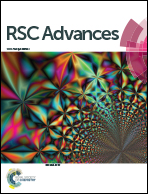Controllable synthesis of unique Ni/mesoporous carbon composites with lightweight and high EM wave absorption performance
Abstract
In present work, Ni/disordered mesoporous carbon (DMC) composites with unique structure have been prepared through a proprietary two-step process combining the sol–gel preparation of DMC and the in situ reduction of Ni from co-precipitated nickel nitrate. Confirmed by scanning electron microscopy, transmission electron microscopy and X-ray diffraction, the Ni nanoparticles were found to be sparsely dispersed in the wormhole-like channel and the mesopores, acting as scattering centres that significantly intensified the electromagnetic (EM) wave multiple reflection and improved the dielectric loss through additional interfacial polarization. Evaluation of the EM absorption properties suggested that the reflection loss (RL) was noticeably reduced from −11.6 dB at 13 GHz to −27 dB at 9 GHz, and the frequency bandwidth corresponding to RL < −10 dB was broadened from about 1 GHz to over 4.5 GHz after incorporation of DMC with Ni. The experimental results show that Ni/DMC composites are superior to neat DMC so that they could be some of the most promising candidates for the new generation of EM absorption materials with improved performance and well-maintained lightweight feature.



 Please wait while we load your content...
Please wait while we load your content...